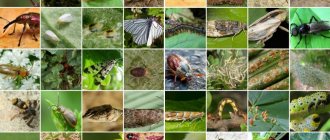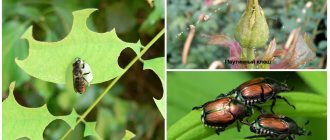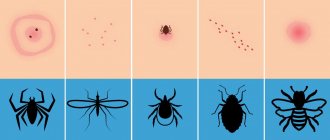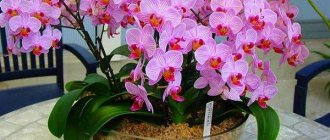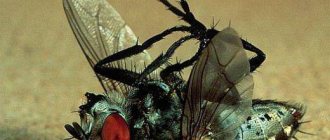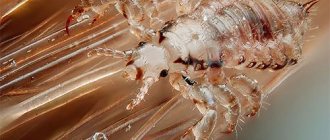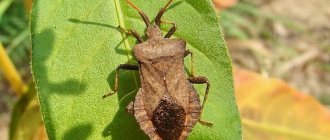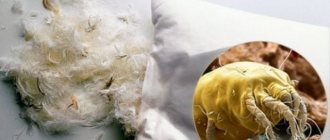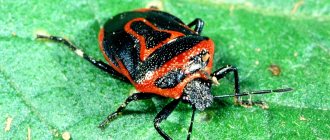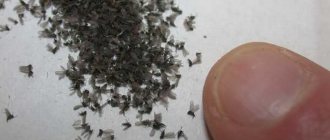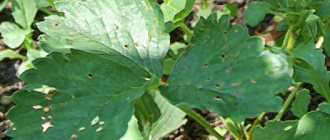Sometimes it happens that unwanted guests - pests - settle in on your favorite orchid. This can happen for many reasons, and the gardener needs to know what to do in this situation to help his tropical beauty.
Let's look at the main pests of orchids and describe the damage they cause to the plant.
If a phalaenopsis is attacked by bulb mites , they suck out the sap from the roots.
Actively eat leaves:
- Thrips larvae,
- Slugs,
- snails,
- Caterpillars.
Drink juices from orchids:
- Nematodes,
- Spider mites,
- Aphids.
If pests are not detected in time and destroyed, the plant may die .
Types of insects: name, description, causes and methods of treatment
Let's talk about the most common insects that can appear on a flower with their photos, descriptions and control methods.
Shield: how to treat?
Scale insects and false scale insects are yellowish-brown insects whose diameter does not exceed 5 mm. They mainly affect weakened orchid plants that are oversaturated with nitrogen fertilizers.
To combat these parasites, use a soap-garlic solution, ethyl alcohol and a soap-oil emulsion. The following insecticidal preparations are used: Fitoverm, Aktara, Aktellik.
White mealybug
Miniature insects with antennae and an oblong body, 3-6 mm in size, similar to snow-white lumps of cotton wool. They settle on flowers that are weakened and oversaturated with nitrogen fertilizers. To eliminate them, the plant is sprayed twice with Fitoverm.
Read more about mealybug control and signs of infestation here.
Poduras or multi-tails and the fight against them
Poduras, or polytails, are translucent white or light brown caterpillar-like insects. Pests appear as a result of excessive irrigation when moisture stagnates and silt deposits form.
You can get rid of polygons using the following means:
- washing the plant with soapy water;
- replacing 3-4 cm of the top soil layer with clean sand or ash for 4-5 months;
- spilling the substrate with Aktara, Fitoverm or Mospilan.
If there are a lot of dams, irrigation is reduced by half. If the roots rot, they are removed and the plant is replanted.
Thrips
Small insects no larger than 2.5 mm in size with paired wings that resemble sticks in appearance, multiplying rapidly in dry and warm environments. To get rid of them, the plant is isolated and then treated with Fitoverm or Actellik.
You will learn about what types of thrips attack an orchid and how to get rid of them from this article.
Nematodes
Nematodes are thread-like, half-transparent worms, 0.5-1 mm long. They integrate into the leaves, root system and buds of orchids and feed on their juice.
The causes of infection by nematodes may be the proximity of an infected plant, irrigation with poor-quality water, or transplantation into an affected substrate.
A hot shower, isolating the plant and treating it with antiparasitic drugs - Decaris or Levamisole - helps to destroy pests. In the fight against larvae and adult insects, treatment with insecticidal agents is effective: Fenamiphos, Carbofuran. In advanced cases, they resort to replanting the plant and calcining the prepared substrate in the oven.
Ticks
Small and very dangerous pests that are difficult to detect in a timely manner. There are bulbous, armored and spider mites. To combat them and to prevent the appearance of pests, heat treat the substrate in the oven for 5-10 minutes at a temperature of 150-180 degrees.
Read how else to deal with spider mites and oribatid mites here.
Aphid
A half-transparent flying insect 1-4 mm long. Aphids are found in greenish, black and whitish colors. The plant is attacked by insufficient irrigation and low humidity.
If the pest population is small, the bush is washed with clean warm water. When there are a lot of insects, the plant is treated with a soap solution or foamed laundry soap. Among chemical agents, a 3% solution of Chlorophos helps.
Whitefly or what to do if there are small insects in the soil?
A whitish insect with wings measuring 1-1.5 mm. Easily moves from one plant to another.
White bugs attack orchids due to high humidity, heat and poor air circulation.
Treatment of plants requires an integrated approach. The flower is washed with water and laundry soap. In such cases, processing of green mass with substrate, carried out using Aktara, Vertimek or Fitoverm, also helps. The second spraying is performed a week after the first.
Helps prevent re-invasion of whiteflies:
- increasing the humidity level in the room;
- systematic wiping of foliage;
- monthly watering of the soil under running water.
Snails, slugs and woodlice
Insects with an oblong shape and a scaly shell. They are dark gray and yellow marbled, with 7 pairs of legs. They often get into the soil in a plant pot when it is outdoors. You can actually lure them with a piece of cucumber or apple, then collect and dispose of them.
You can get rid of pests by washing the roots and replanting the plant in a fresh substrate.
Caterpillars
Any butterfly can visit an orchid standing outside and lay larvae on the foliage. If the clutch is not detected in a timely manner, the caterpillars will hatch. These are very voracious pests, capable of destroying the entire green mass in a short period of time.
It is possible to catch a few caterpillars by hand or spray the plant:
- onion or garlic infusion;
- wormwood decoction;
- peppermint tincture.
To combat numerous individuals, use “Dichlorobenzene” (acephate), acting according to the instructions.
Centipedes
These insects have an elongated body and many legs. Color varies from gray to rich brown. They move at high speed, making them difficult to catch.
Pests can be caught using bait made from potatoes, cucumbers and apples.
Some orchid owners place beer baits in flower pots. You can spill the substrate with warm water or spray it with Actofit or Bitoxibacillin. Transplanting the plant into a new substrate helps in the fight against them.
Root mealybug
Root insects are gray-yellow or light pink. They have an oval body and a length of 2-4 mm. They suck out the juice from the roots, which can lead to the death of the plant.
To fight the parasite:
- The flower is removed from the pot;
- The rhizome is washed and disinfected in a weak solution of manganese.
- The old substrate is disposed of and the pot is disinfected.
- The orchid is planted in new soil.
You can resort to treating the substrate with a dry contact-intestinal insecticide. Irrigation will lead to the dissolution of the powder and the death of insects.
Sciarids or midges
Miniature black midges that live in the soil. Their length is 3-4 mm.
The greatest threat to the orchid is the sciarid larvae; they eat the roots and cause enormous damage to the plant.
The appearance of fungus gnats is associated with systematic waterlogging of the soil. You can get rid of them by drying the substrate and irrigating with insecticides. The drugs are used according to the instructions. For flying species, aerosols must be used. The containers are treated until the pests are completely gone.
Why might pests appear on an orchid?
There are many reasons for the appearance of insects that harm the orchid. The main ones are:
- the flower purchased was infected in the store;
- use of contaminated substrate;
- transfer of pests from a neighboring plant.
Important! In any of these cases, immediate measures must be taken to save the orchid.
Buying an already infected flower
Store orchids are not always kept in ideal conditions. In addition, a large accumulation of flowers in one place greatly increases the risk of disease or pests.
A healthy phalaenopsis can be distinguished by the following characteristics:
- leaves are bright green, elastic, dense, smooth;
- roots are green or golden, elastic, hard;
- It is desirable to have a young leaf in the rosette;
- flowers or buds are placed on a strong peduncle.
If the leaves are wrinkled, covered with a sticky white coating, their plates are dotted with spots and dots, then the orchid is infected. Limp, brown, moldy roots also indicate the presence of disease or pests. This type of phalaenopsis cannot be purchased.
Reference! Before purchasing, you should shake the flower pot. A healthy orchid is firmly anchored in the flowerpot by its roots. If the plant dangles in the container, such a purchase should be abandoned.
Pests in the substrate
Soil taken from a street flower garden is highly likely to be contaminated. You can also introduce pests into the soil by making your own substrate. It is enough for one of the necessary ingredients to be infected.
Reference! To protect the flower, it is recommended to buy ready-made substrate for orchids in specialized stores.
Transfer of insects from another plant
If they want to maintain the design of the room or in order to save space, some owners place flowers in one place too close to neighboring ones. This can be observed especially often on window sills. In this case, if one specimen is infected, there is a high probability of pests spreading to neighboring orchids.
Reference! Experienced gardeners recommend maintaining a distance of 25–50 cm between flower pots. The main criterion is that the plants should not touch each other with their leaves.
Signs of flower infection
Several signs can indicate a pest infestation.
- The appearance of black spots on the foliage: they indicate a spider mite infestation.
- Silvery or moldy coating on leaves, peduncles, roots or buds.
- Redness and curling of leaf blades.
- Wilting of the plant.
- Root system rotting.
- The appearance of white, yellow, brown dry or wet spots on the leaves.
Spots on leaves sometimes occur from viral and bacterial diseases, as well as from violations of care conditions. Find details here.
What danger do they pose?
Since pests feed on the juice and nutrients found in the orchid, its growth stops, flowering stops or becomes scarce, the leaves change shape and become elongated. After a while, the phalaenopsis will begin to wither and then die. What parts of the plant are affected? Pests mainly attack the stems, roots and leaves of the plant ; they suck the juice from these elements, as a result of which the flower withers and dies.
How to get rid of it: step-by-step instructions
The method of getting rid of pests depends on the type of parasite and the degree of infection of the orchid. In some cases, folk remedies help, in others you have to use chemicals.
To save a plant from pests, you must:
- Isolate the orchid from other flowers.
- Carefully inspect the plant and remove any parasites found.
- Cut off damaged areas of greenery, sprinkle these areas with crushed coal, and treat with an antiseptic.
- Place the container with the flower in water for a few minutes. This will get rid of insects that float to the surface.
- Wipe the flower with a sponge dipped in soapy water. For varieties with dense foliage, you can use alcohol, the main thing is not to burn the green mass during this treatment.
- Replace the topsoil or the entire substrate. In some cases, a pot change is required.
Next, if necessary, treatment should be carried out with one of the chemical or biological agents.
Podura (springtails)
Podura
Pests are small insects that jump on the substrate. Most often, these gray-white or gray-brown insects can be seen on the surface of the substrate after watering. Podurs are typical inhabitants of moist substrate. Most often they appear on orchids that grow in moss. It is difficult to catch insects: they are quite nimble and jumping. The most dangerous fools are that they eat young roots. Therefore, these pests need to be removed as soon as possible, without giving them the opportunity to multiply and destroy the orchid.
Reason for appearance
The appearance of undergrowth indicates that the orchid is kept in a substrate that is too wet.
How to get rid of idiots
First of all, you need to eliminate the cause of their appearance - dry the substrate. You also need to reduce watering for a while and sprinkle the surface of the soil with sand. After this, the plant needs to be sprayed with Fitoverm.
Prevention
The place where the orchid stands must always be kept clean - in this case, the plant will never harbor poduras and other insects harmful to home flowers.
Chemical and biological agents
You can rid your orchid of pests using the following medications:
- Aktara.
- Actellik.
- Fitoverm.
- Agravertine.
- BI-58.
Aktara: use and dosage in ampoules
It has an extensive intestinal-contact effect and helps well in the fight against various types of insects from scale insects to thrips and aphids. This is a safe product that provides the orchid with protection from pests for 2 weeks. Available in ampoules and powder. Ampoules are often used to treat indoor plants.
Dosage of dilution of the drug: a 1.2 gram ampoule is diluted in 6 liters of water and the plant is sprayed.
There should be weekly intervals between treatments. Aktar can be used in combination with Epin and Zircon.
Actellik: how to dilute?
A systemic insectoacaricidal agent that has proven itself in the fight against harmful insects that attack orchids. For long-term protection, a single treatment is usually sufficient. Actellik serves as a working solution. 1 ml of product is diluted in one liter of liquid.
The roots and stems, as well as foliage, are treated with the drug. If necessary, the procedure is repeated after 7 days. For maximum effectiveness, the treated plant is placed in polyethylene and kept for several days in a ventilated room.
Actellik is a drug of the second class of toxicity. When using it, it is important to follow safety precautions, use gloves, goggles, a respirator, and carry out processing outdoors.
Spray Bona forte
Suitable for getting rid of many crawling and flying insects.
It is best to carry out the treatment in the morning or evening in diffused light. Before use, it is better to test the spray on several leaves. If after 1-2 days everything is in order, then you can completely irrigate the flower. If necessary, the soil can also be treated with a spray.
Fitoverm
Biological insectoacaricidal drug that helps in the fight against mealybugs, aphids, mites, thrips. The remedy is used based on the type of parasite. To destroy spider mites, 1 ml of concentrate is diluted in 1 liter of liquid. For aphids – 1 ampoule in 600 ml of water. For thrips – 1 ampoule in 0.5 liters of water. In other cases, the dosage is 1 ml of product per 1 liter of liquid.
To destroy parasites, spraying with Fitoverm must be performed 4 times with an interval of 10 days.
How to treat the plant?
The choice of control method depends on the type of pest and the degree of infestation of the plant. Sometimes treating the flower with a soap solution is enough. But most often it is necessary to use potent drugs.
How to treat with chemicals?
The use of chemicals provides a guarantee of getting rid of all types of parasites. They can penetrate the pest’s body through contact, through the intestines, and systemically (in both ways).
The chemicals are harmful to humans and animals. They are divided into classes according to the degree of danger. The higher the class, the more toxic the drug. The most popular chemicals are:
- Aktara (grade 3) has a wide spectrum due to its systemic effect on parasites.
- Actellik, Karbofos (2nd class) are used against ticks, scale insects, fleas and aphids. Most often, one treatment is sufficient.
- BI-58 (class 3) is a universal drug with a wide spectrum of action. Process 1 time.
- Acaricides (Fufaron, Antiklesch, Neoron) are indispensable for getting rid of ticks.
Attention! Chemicals are used according to instructions in the fresh air or in a well-ventilated area.
How to fight with folk remedies?
Small colonies of pests are removed by spraying with decoctions and infusions. Well proven:
- yarrow;
- chamomile;
- nettle;
- marigold.
The grass is scalded with boiling water and kept in it for a day. Using a spray bottle, spray phalaenopsis daily until the pests completely disappear:
- To prepare a soap solution, dilute 50 g of finely ground laundry soap or 1 tablespoon of liquid soap or detergent in 1 liter of water. The entire flower is washed generously with the solution.
- 40 g of tobacco dust is stirred in 1 liter of water, left for 24 hours, filtered. The entire flower is sprayed with the solution.
- A medium-sized onion is passed through a fine grater, poured 1 liter of boiling water, left for 7 hours, filtered. The resulting infusion is sprayed onto the ground part several times a day for 4–5 days.
Reference! Steamed citrus peels dug into the substrate cleanse it of pests.
Biological drugs
They contain plant components and a small dose of poisons. Harmless to humans, do not accumulate in the plant, and do not cause addiction to pests.
The most famous are:
- Fitoverm;
- Bicol;
- Nemabact;
- Bitoxibacillin;
- Aversectin S;
- Lepidocide.
Reference! Despite their safety, medications should be used according to instructions.
Soil treatment
To combat pests and their larvae living in the substrate, mandatory soil treatment with water, solutions or special compounds is required:
- To get rid of many parasites and larvae, it is enough to wash the soil in warm (40 °C) running water for 3–5 days.
- If a scale insect is detected, the substrate is shed with a systemic insecticide.
- To combat the nematode, 1 tablet of levamisal should be dissolved in 1 liter of water and water the substrate generously. The treatment is repeated after 5–7 days.
- If a scale insect is detected, the substrate with the lower part of the orchid is sprayed with Fitoferm. After 7–10 days, the procedure is repeated.
Prevention measures
The condition of the orchid must be monitored from the moment of its purchase. This will protect the flower from harmful insects.
- When purchasing, carefully inspect the plant.
- From time to time, inspect for spider webs with spots.
- Provide diffuse lighting for 12 hours a day.
- Regular spraying in the morning prevents waterlogging and drying out of the soil.
- Use settled water at room temperature for irrigation.
- Monitor the temperature: during the day the recommended value is 22-27 degrees, and at night – 15-20 degrees.
- Do not neglect the timely application of complex fertilizing.
- For replanting, use a soil mixture prepared by yourself, disinfect it by freezing or roasting in the oven.
What should you avoid in insect control?
If you notice that the condition of your plant has worsened, then do not panic and take on all methods at once. Clearly identify the problem based on symptoms and approach treatment wisely . Timely intervention will definitely help save the life of your flower. You should not overuse various types of chemicals, because an orchid is a delicate flower.
There is no need to experiment with different methods of struggle; if one specific remedy is chosen, then it should be used to the end.
How to check a flower for harmful insects?
Unfortunately, many people neglect such a simple procedure, as a result of which they endanger not only the orchid, but also other flowers in their home.
The check is quite simple.
- To do this, you need to remove the plant from the plastic protective bag.
- The inspection begins with the roots, which are probably clearly visible through the plastic container. Make sure they are intact, without rotting or dried rhizomes.
- The substrate must be homogeneous, without traces of any insects.
- Pay attention to the leaves. They should be healthy, fleshy, bright or dark green in color, with no signs of lack of moisture.
- Gently run your hand along the stem. It should be smooth, without thinning, as well as strange bumps in its structure.
- Flowers should be bright, elastic, tightly fitting.
Attention! After the visual inspection is completed, thoroughly water the orchid. If there really are insects, then perhaps they will flow out of the drainage system of the pot along with the water. Pests can be easily seen in clear liquid.
Whitefly
The pests are small white butterflies that can fly quickly and hide among any parts of the plant, even in the bark. When you touch an orchid or soil with your hand, the butterflies quickly take off. They prefer to sit on dense, leathery leaves. Oviposition is located under the bark and lower edges of leaf blades. They hatch into white and yellow larvae, which, like butterflies, feed on plant sap.
The pest’s actions leave white-yellow stains on the leaf blades, and sweet nectar in the biting areas. The fight against whiteflies consists of hanging sticky fly strips indoors. Damaged orchids should be washed with a soap solution in a ratio of 1:6; you can wipe all green parts with a soapy sponge.
The flower itself and the soil under it need to be sprayed with Actellik, then repeat the treatment after 7-8 days. For prevention, it is recommended to increase air humidity, regularly wipe the leaves (every 5 days), and spray the soil with a stream of water monthly.
Orchid pests
Folk methods of saving from bugs
Folk recipes also help to destroy many pests:
- spraying twice a day with a water-oil solution (2 tablespoons of olive oil per 2 liters of water);
- prepare an infusion of garlic (4-5 cloves per 500 ml of boiling water), leave for 4 hours, then rub all the green parts of the orchid with the infusion;
- a soap-alcohol solution for wiping is prepared from 15 ml of alcohol, 1 tbsp. l. grated laundry soap per 1 liter of settled water;
- tincture of orange peels (50 g per 1 liter of boiling water), set aside for a day, then spray all parts of the flower.
The listed pests can attack orchids at any time of the year. Methods of combating them and active measures will help to positively resolve the question of amateur gardeners about what to do if white bugs are infested in orchids. You can save your beloved and such beautiful flowers only with accurate identification of pests. This will help you take the right control methods to save your orchids.
Root mealybug
In addition to the mealybug, its root type can be found among the soil and aerial roots of orchids. Bugs differ in color: light gray, yellowish, less often pinkish small insects. Such scale insects damage the root system of the flower, settling in soil with good aeration.
Root bug on an orchid
On a note!
It is always difficult to detect yellow or white bugs in the soil of orchids if the pot is opaque. Its appearance is signaled by a deterioration in the appearance of the plant when it begins to sharply wither.
To get rid of pests, the following steps will help:
- shake the orchid out of the container, rinse the roots well;
- disinfect with a weak solution of potassium permanganate;
- throw away the old soil and treat the pot thermally (boil);
- Some gardeners use dry insecticide in contaminated soil, then after watering the orchid will absorb the resulting toxic solution, feeding on which the parasites will die.
